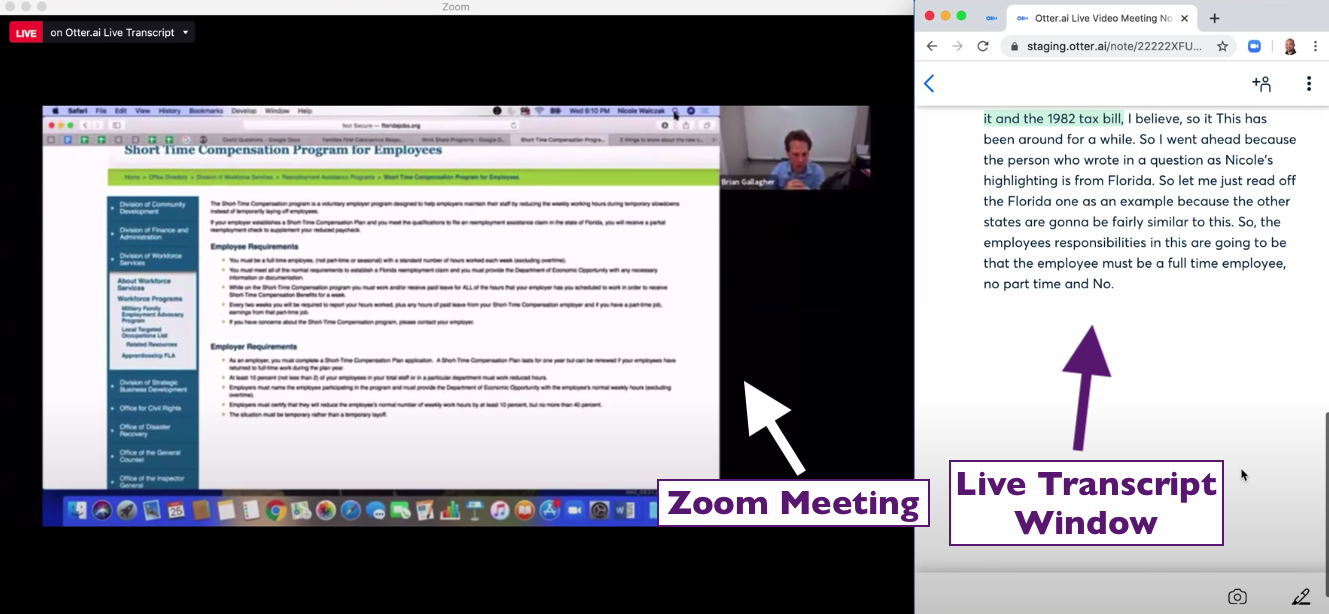Strategies from the Amherst Classroom

In 2021, Otter AI live transcription and auto captioning technology was added to Zoom as a feature. Learn how to enable Zoom's Auto-Caption/Transcription feature.
Jump to: Strategy 1 - Participate by Reading Live Transcripts ♦ Strategy 2 – Augment Class Notes with Meeting Transcription ♦ Strategy 3 - Increase Student Engagement
The following screenshot is taken from a video provided by Otter AI, demonstrating the use of the transcription process during a live Zoom meeting:

Strategy 1 - Participate by Reading Live Transcripts
Faculty: Trent Maxey
Course: HIST-477-01 - History and Memory of the Asia-Pacific War
Class Size: 15 students
Learning Design – Enable participation of students through alternate mode, generate text of live lectures
Evidence from Student Learning:
Professor Trent Maxey used Otter AI tool mainly for a student who was hard of hearing in his course for Fall of 2020. This transcription tool provided the student with a live transcript of the class discussion and a transcript that the student could save and refer back to after class. As a result, the student was much more relaxed and clearly better able to follow what others were saying.
Reflecting on his experience with Otter AI, Maxey summed up his experience this way, “it was a lifesaver for my student. Without it, they would either have had to give up participating in the seminar for the remainder of the semester, or we would have had to hire a student to produce notes of the seminar.”
Strategy 2 – Augment Class Notes with Meeting Transcription
Faculty: Sean Redding
Course: HIST-301-2021F - Proseminar in History: Writing the Past
Class Size: 14 students
Learning Design – Generate notes of meetings with students
Evidence from Student Learning:
Professor Sean Redding considered that Otter AI did a pretty good job of transcribing class lectures, and the student with hearing impairment in her course was able to keep up with the discussion and download the notes for reviewing later. A couple of other students referred to the notes. Professor Redding thought that some of them also used Otter's transcriptions to augment their own notes. In fact, Professor Redding's thesis student also found it very useful for keeping notes on their meetings. For the most part, her thesis student did not take a lot of notes as they talked in their one-on-meeting, but the student found the Otter AI notes to be helpful as she went back to incorporate some of Professor Redding's suggestions. Professor Redding summed up her experience saying, “Otter was a very positive experience, and I'm glad to have it as a tool that all the students can use!.”
Strategy 3 - Increase Student Engagement
Faculty: Kate Follette
Course: ASTR-228-2021F - Introductory Astrophysics ♦ ASTR-337-2021F - Observational Techniques
Class Size: 12 and 7 students
Learning Design – Produce transcripts of live lecture in place of recording
Evidence from Student Learning:
Professor Kate Follette set up a poll and collected feedback on the extent to which Otter AI contributed to student engagement in her two courses. In her lower division 12-student course, only 6 students reported using Otter once or twice, and 6 reported that they didn't use it at all. In her 7-student advanced class, there was a little more use - 2 students used the transcripts biweekly, 4 a few times, and one not at all.
According to Professor Follette, the main advantage of Otter AI for her courses was that it allowed her to give students a transcript of what was discussed in class without having to record and upload the Zoom sessions, which is very time-consuming. Even though her students didn't use it much, they had asked her at the start of the semester if they would have access to recordings/slides. Professor Folette thought this was the easiest way to provide that access.
Updated Fall 2022 by Academic Technology Services